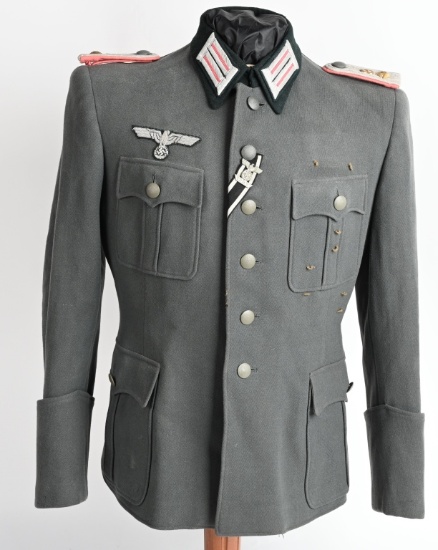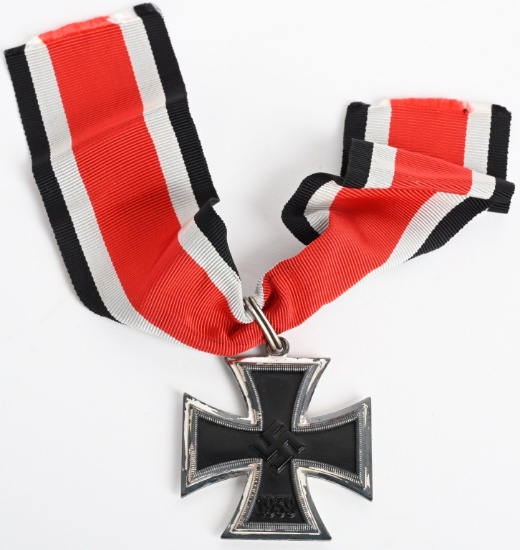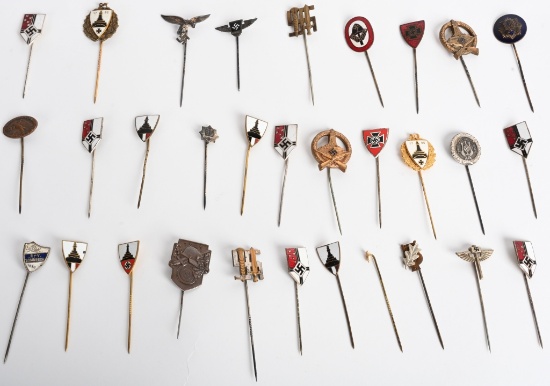
PREMIER MILITARIA & EDGED WEAPONS AUCTION

PREMIER MILITARIA & EDGED WEAPONS AUCTION
See Special Terms for additional fees
Cash Payment Discount: 3%
Description
PROUDLY PRESENTS
PREMIER MILITARIA & EDGED WEAPON AUCTION
OVER 700 LOTS OF MILITARIA FROM THE 18TH TO THE 20TH CENTURY. MORE THAN 25 LOTS of CIVIL WAR INCLUDING SWORDS, ACCOUNTREMENTS, IMAGES and MORE, INCLUDING AN IDENTIFIED CONFEDERATE POW'S SHELL JACKET;
WW1 and WW2 US GROUPINGS, EDGED WEAPONS, HELMETS, MEDALS, FLAGS, UNIFORMS, INSIGNIA, PATRIOTIC POSTERS and MORE INCLUDING MERRILL'S MARAUDERS GROUPING, NAMED MEDAL GROUPINGS, PAINTED COMBAT HELMETS, AND MORE. 30 PLUS LOTS of IMPERIAL GERMAN SWORDS, HEAD GEAR, MEDALS and MORE. 400 PLUS LOTS of WW2 NAZI GERMAN ITEMS INCLUDING a TRANSITIONAL WAFFEN SS HELMET, NAZI GERMAN ORG. TODT UNIFORM, NAZI GERMAN DIPLOMAT DAGGER, BADGES, MEDALS, INSIGNIA, HELMETS, UNIFORMS, SWORDS, BAYONETS, ACCOUTREMENTS, NSDAP PARTY UNIFORMS and MUCH MUCH MORE! JAPANESE ITEMS INCLUDING A PARATROOPER PARACHUTE, JAPANESE KATANA SWORDS, TANTOS, FLAGS, MEDALS, BADGES and MORE. KOREAN AND VIETNAM WAR LOTS, INERT ORDNANCE COLLECTION INCLUDING AN E1R1 FLAMETHROWER, INERT RPG, INERT MORTARS, INERT... Show more Show Less
Cash Payment Discount: 3%
Participation Requirements: Valid Credit Card required for bidding approval
Payment Options: Visa, MasterCard, Discover, American Express, Check, Money Order, and Wire Transfer
Visa MasterCard Discover American Express
Payment Instructions: SALES TAX All buyers will pay applicable state sales tax. Sales tax is require if mandated by the state you reside in for all internet sales and will be added to your invoice. If buyer provides a current state exemption form there will be no sales tax added. PAYMENT All merchandise must be paid in full within ten (10) days of the date of the sale. Purchases totaling $20,000 or more must be paid within three (3) days of the date of the sale. Call 440-527-8060 to pay your invoice by phone or mail payment to: 38198 Willoughby Parkway, Willoughby Ohio, 44094. Absentee bids placed through www.milestoneauctions.com and Proxibid.com will be auto charged to the credit card entered 48 hours after the end of the sale. If you wish to pay by another method please contact us within 48 hours after the sale. We accept Visa, MasterCard, Discover, personal checks/ certified checks, wire transfer, money orders, and cash. CREDIT CARD - For first time buyers and credit card charges greater than $2,500.00 buyers must complete the bottom portion of the invoice and must specifically sign the acknowledgement of our terms of sale before we will accept payment via credit card. We do offer the convenience of paying automatically by credit card. If you wish have your card automatically charged for all purchases please complete our Authorization for Automatic Credit Card Use. We have this form available upon request. Split payments are subject to a 23% buyer premium if a credit card is used as any form of total payment. CHECK - There will be a $30.00 service charge for returned checks. Make checks payable to: Milestone Auctions LLC. Milestone Auctions reserves the right to hold items paid for by personal or company check until said check clears (14 days). Milestone Auctions has the right to hold all checks over $2,000.00. Customers who have an established successful buying In the few situations where a successful bidder does not remit payment when due, Milestone Auctions will proceed with the legal steps necessary to protect its interests and will block the bidder from future auction participation.
Currency Type: USD
Shipping Instructions: Please see our terms and conditions.
Preview Date & Times: Items are available for preview 7 days prior to the sale by appointment. Auction day preview is February 13th at 8AM.
Checkout Date & Times: Please contact the auction company for checkout dates & times.
Location: 38198 Willoughby Parkway, Willoughby, OH 44094
Driving Directions:

By clicking "Confirm Buy" you are agreeing to the terms of the sale. Instant Purchase items may have additional fees such as an Internet Premium, Sales Tax, Shipping or other fees not included in the Instant Purchase price. Please see Auction Information for full details.
Payment Type:
WWII OPERATION CROSSROADS USS DIXIE DOCUMENTS WW2
Lot # 584 (Sale Order: 651 of 784)
WWII US PATRIOTIC BANNER FLAG W/ UNCLE SAM WW2
Lot # 585 (Sale Order: 652 of 784)
WWII NAZI GERMAN ADOLF HITLER POSTCARD LOT W OTHER
Lot # 586 (Sale Order: 653 of 784)
WWII NAZI GERMAN MEDAL & INSIGNIA PATCH LOT WW2
Lot # 587 (Sale Order: 654 of 784)
WWII NAZI GERMAN RAD EM/NCO'S OVERSEAS CAP WW2
Lot # 588 (Sale Order: 655 of 784)
WWII NAZI GERMAN CLOTH INSIGNIA LOT HEER NSKK LUFT
Lot # 589 (Sale Order: 656 of 784)
WWII GERMAN NAZI MEDAL LOT NARKIK SHIELD SA LUFT
Lot # 590 (Sale Order: 657 of 784)
WWII NAZI GERMAN POLICE NCO'S M43 FIELD CAP WW2
Lot # 591 (Sale Order: 658 of 784)
WWII NAZI GERMAN RAD 1935 WALL PLAQUE ABTELUNG WW2
Lot # 592 (Sale Order: 659 of 784)
WWII NAZI KNIGHT'S CROSS OF THE IRON CROSS 935 MKD
Lot # 593 (Sale Order: 660 of 784)
WWII NAZI M17 SS TRANSITIONAL WAFFEN SS HELMET WW2
Lot # 594 (Sale Order: 661 of 784)
WWII NAZI GERMAN SA M33 DAGGER F. DICK WW2
Lot # 595 (Sale Order: 662 of 784)
WWII NAZI CAVALRY TROOPER'S M34 SADDLE BAG SET WW2
Lot # 596 (Sale Order: 663 of 784)
WWII US & NAZI GERMAN PROPAGANDA POSTER LOT WW2
Lot # 597 (Sale Order: 664 of 784)
REPRO WWII NAZI GERMAN CASED KNIGHTS CROSS L/12
Lot # 598 (Sale Order: 665 of 784)
WWII JAPANESE CASED Ko-sho TYPE 2 WOUND BADGE WW2
Lot # 599 (Sale Order: 666 of 784)
WWII NAZI GERMAN WAFFEN SS SD HELMET SHELL Q66 WW2
Lot # 600 (Sale Order: 667 of 784)
ADOLF HITLER SILVERWARE PERSONAL TABLE SERVICE
Lot # 601 (Sale Order: 668 of 784)
ADOLF HITLER SILVERWARE PERSONAL TABLE SERVICE
Lot # 602 (Sale Order: 669 of 784)
WWII NAZI GERMAN WAFFEN SS MOUNTAIN TROOP M43 HAT
Lot # 603 (Sale Order: 670 of 784)
WWII NAZI GERMAN PHOTO ALBUM LOT HEER LUFTWAFFE
Lot # 604 (Sale Order: 671 of 784)
WWII ITALIAN PILOT & BOMBER WINGS LOT OF 3 WW2
Lot # 605 (Sale Order: 672 of 784)
WWII NAZI GERMAN WAFFEN SS POLICE DOCUMENT GROUP
Lot # 606 (Sale Order: 673 of 784)
WWII NAZI GERMAN STICKPIN LOT NSKOV RLB HEER WW2
Lot # 607 (Sale Order: 674 of 784)
WWII NAZI GERMAN STICKPIN LOT PANZER RLB SA NSKOV
Lot # 608 (Sale Order: 675 of 784)
| Bid Range | Increment |
| $0.00 - $299.99 | $10.00 |
| $300.00 - $999.99 | $25.00 |
| $1,000.00 - $1,999.99 | $50.00 |
| $2,000.00 - $4,999.99 | $100.00 |
| $5,000.00 - $9,999.99 | $250.00 |
| $10,000.00 - $24,999.99 | $500.00 |
| $25,000.00 - $49,999.99 | $1,000.00 |
| $50,000.00 - $99,999.99 | $2,500.00 |
| $100,000.00+ | $5,000.00 |

 x Cancel
x Cancel























